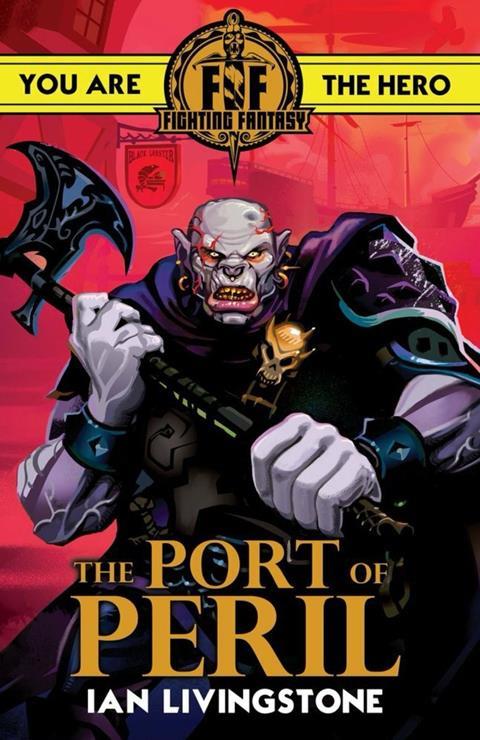Netflix is banking on the ‘choose-your-own adventure’ format as a key differentiator but do branching narrative formats work for TV?
Reports that Netflix is using a forthcoming episode of Charlie Brooker’s scripted anthology series Black Mirror to pilot an interactive ‘choose your own adventure’ feature conjures up memories of those 1980s Fighting Fantasy role-playing books

At their peak authors Ian Livingstone and Steve Jackson, also the co-founders of Games Workshop, sold 20m copies of the multiple choice adventure books, which saw readers confront orcs and mirror demons - before the video game explosion eclipsed the book format.
“The mechanism of choice and giving control to people is a very powerful thing” - Ian Livingstone
Now the genre is set to make a comeback on a TV/ mobile/ Alexa device near you, thanks to a raft of new technologies and SVODs keen to expand their subscriber base.

Scholastic, meanwhile, has republished the Fight Fantasy series and Livingstone reveals that he’s also in talks with Amazon to stream a voice version of the series on Alexa.
According to the gaming entrepreneur and Ukie vice chair, the interactive endings genre has the potential to transfer well to scripted TV series, provided that it is handled right.
“The mechanism of choice and giving control to people is a very powerful thing - but how you facilitate that and on what platform needs to be carefully considered,” Livingstone warns.
He adds that even within the gaming industry, examples of choose-your-own adventure narratives are sparse because anything possessing a branching narrative is, by Livingstone’s own admission, “hard to write”.
Branching narratives
Livingstone used a manual flow chart to map out the plot of his fantasy books, keeping a record of every key decision and consequence. He adds that he also recorded ‘pinch points’ - the crucial bits of information that all readers needed no matter what their direction of travel.

“You also need to make sure that it’s balanced in terms of gameplay. There are multiple things to consider - so when you add film into the equation that’s a whole other layer of complication and cost,” he adds.
Tellingly, most people experimenting with audio and TV versions of the genre now have designed narratives that are not completely branching.
HBO’s Steven Soderbergh-directed drama Mosaic, a Sharon Stone-fronted murder mystery, ran as both a linear TV show (which aired earlier this year) and as an app, allowing viewers to customize how they watched the story.
“The user interacting all the time isn’t going to be what defines the story, that’s the job of the narrative” - Nicky Birch
While the Mosaic app worked like an interactive movie, it wasn’t a ‘pure’ version of the branching narrative form because viewers couldn’t affect the plot. Viewers were able to choose the perspective that the plot was viewed from, however, enabling them to learn more about different facets of the story.
The Inspection Chamber
“I’m a firm believer in not having a completely branching narrative - the user interacting all the time isn’t going to be what defines the story, that’s the job of the narrative,” says Nicky Birch, founder of experimental audio production company Rosina Sounds.
Last year BBC R&D partnered with Rosina to create a Hitchhiker’s Guide-style comedy for Amazon Alexa, The Inspection Chamber, which allowed users to shape the direction of the story as they assume the guise of an android waiting to be processed.
According to Henry Cooke, Senior Producer and Creative Technologist at BBC R&D, the drama borrowed more tropes from immersive theatre, rather than the branching narratives typical in video games such as Dave Gage’s PS3 and 4 titles, Heavy Rain and Detroit.
“It’s more like it’s the same story every night but a character might have a different attitude towards you,” explains Cooke.
Cooke says he carried out extensive research into the choose-your-own-adventures genre and came to the conclusion that pure branching narratives don’t work for TV or radio.
“Largely because the user has to switch from directing the story to participating in it, which takes them out of the immersion,” he explains.
Cooke adds that they can also lead to around 30 different endings, which considerably lengthens the production process.

Consequently, The Inspection Chamber doesn’t completely branch, but “bubbles out”, according to Birch, enabling the user to divert before allowing them to return to the same narrative path.
“You can make A, B or C choices and have some impact on the story, but you don’t stray away completely,” she adds.
“In The Inspection Chamber, for example, one of the characters sings the choices you made earlier back at you. It’s an acknowledgement that the drama understands that the listener has purchased in the story,” she says.
BBC R&D created a story engine for the project, which powers the adventure from scratch, enabling the user to give a wide range of answers and for the story to mould around these responses.
The broadcaster also created an in-house story mapping tool called Orator which Cooke likens to “a digital murder wall” that allows the creator to map out chunks of the story on a virtual wall and weave in possible connections between them.
Audience reaction to the BBC’s foray into interactive multiple narrative drama fell into two camps, according to Cooke, who adds that when they initially released the drama they held back on marketing it as either a game or a radio piece.
“We wanted to people to describe it in own terms. What we ended up with were two camps: gamers who wanted more interactivity and linear listeners who wanted less,” he reveals.
New projects
Lessons from The Inspection Chamber have shaped two further R&D projects. The first, released last month (25 November) on Amazon Alexa, is The Unfortunates, which caters more for fans of more subtle interactivity.
The drama – also co-developed by Birch - is a re-working of a linear Radio 3 play starring Martin Freeman, based on a series of boxed chapters that can be read in any order.
The 1969 story, by experimental author BS Johnson, explores the randomness of the mind, through a journalist who travels to a city to cover a football match that triggers long-forgotten memories of a friend who has died.
“Smart speakers have now given us the computational ability to randomize the book to make it true to its original form,” says Birch.
“The new version for voice offers a different version of the original play every single time, for every listener,” he adds.
Cooke also reveals that the BBC R&D is working on a more immersive project for gamers, which is in the “early planning stages” and is due to go into production early next year.
Livingstone meanwhile, reveals that multiple choice adventures are about to enter a whole new phase thanks to a patented pinching and scrubbing technology that allows players on touch screen devices open up objects within the video stream. Flavorworks, a gaming company Livingstone chairs, is working on a ground-breaking new murder myster title called Erica for Sony PlayStation. “There are points where you can manipulate footage itself, it’s going to be revolutionary,” he claims.
Le Judas
Couzin Film’s award-winning online video 12x10-minute interactive crime drama Le Judas, originally broadcast on Radio-Canada.ca, invites players to unravel a murder mystery by immersing themselves in the action.
It’s not a pure branching narrative, because there’s only one killer, but viewers are invited to choose how their adventure unfolds and might end up choosing the wrong suspect, as they are taken down a series of rabbit holes.

“A project like this can only succeed if the interactive elements are more than just a gimmick,” says Sophie Ferron, president of Media Ranch Distribution - which is selling the format internationally.
To ensure the experience was authentic Couzin Film mapped out the story in two parallel sections: story beats and interactive beats. “They charted each side-by-side to see how the interactive elements truly help tell the story, and alter it,” Ferron explains.
Because interactivity is required by the player at every step of the process, this doubled development time. Complex Excel sheets were also created and each character was put on a chart, with their actions detailed and scenes described from multiple perspectives.
According to Ferron, the editing process also required more work: “We edited more than we needed so that the story could adjust based on the interactions with the audience,” she says.
Audience reaction to the game was very positive, which Ferron believes stems not from viewers “choosing” the story but from being a part of its telling and even its creation. She says: “What works is giving the audience legitimate interactive experiences, where they truly sense that their decisions can alter the story, and maybe even derail it.”
























No comments yet